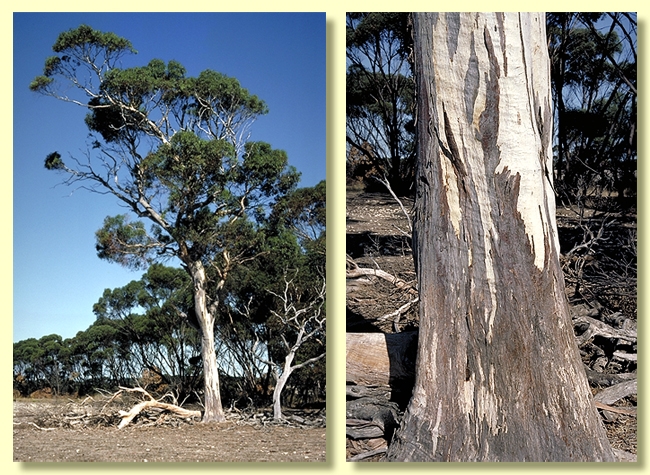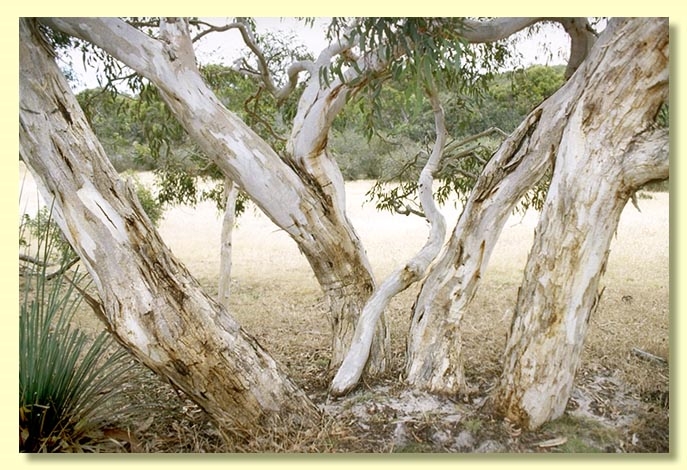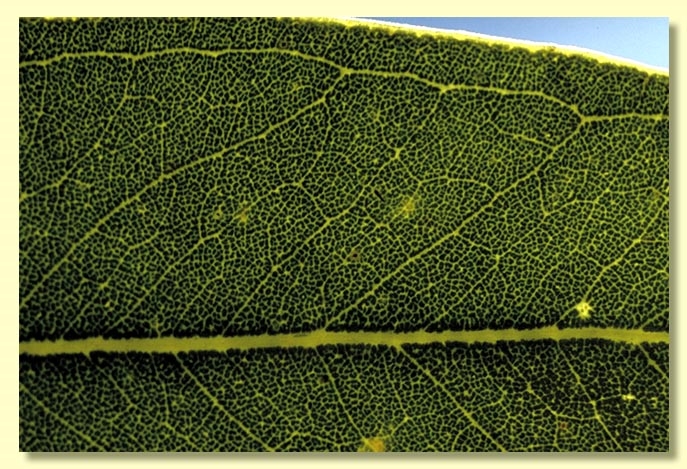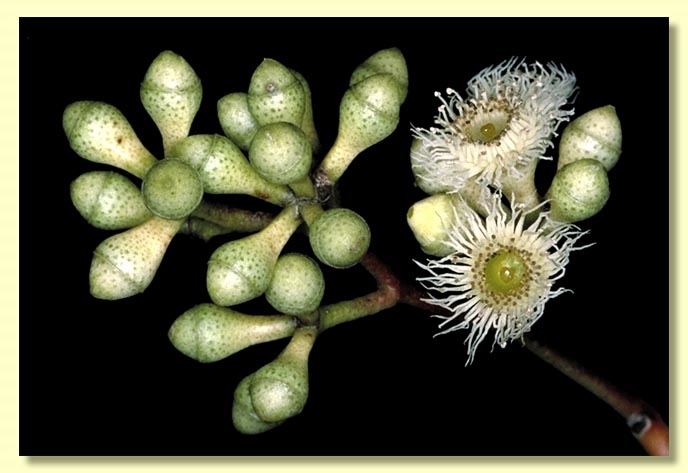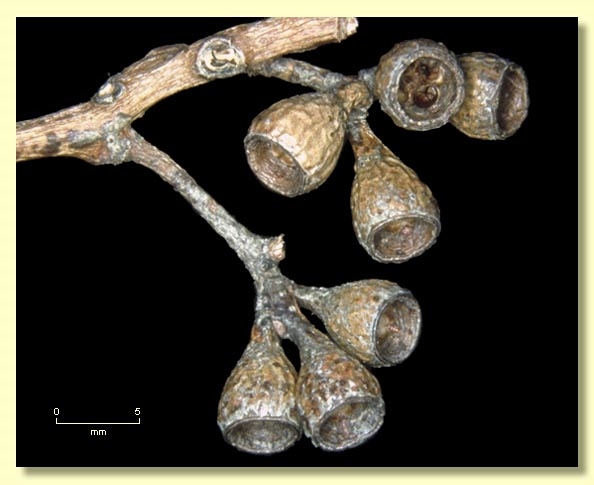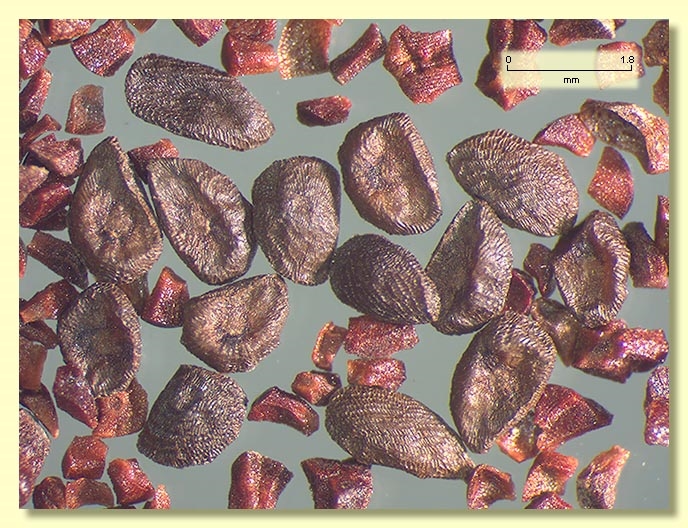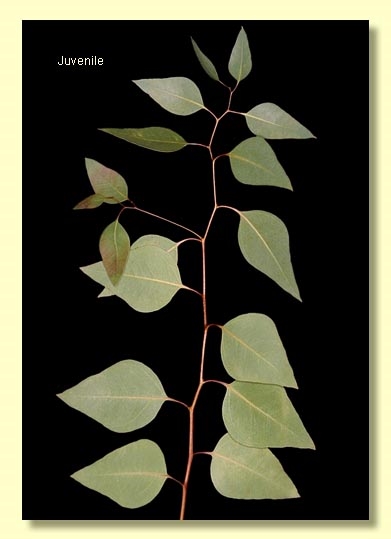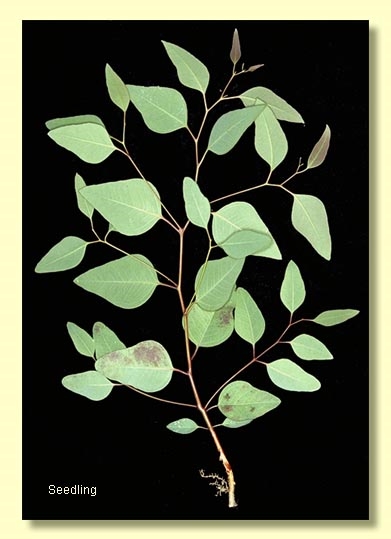Euclid - Online edition
Eucalyptus fasciculosa
Eucalyptus | Symphyomyrtus | Adnataria | Terminales | Heterophloiae
T: Bugle Ra., S.A., Aug. 1850, F.Mueller s.n.; lecto: MEL 10340, fide J.H.Willis, Muelleria 1: 166 (1967).
Eucalyptus paniculata var. fasciculosa (F.Muell.) Benth., Flora Australiensis 3: 212 (1867).
Tree or rarely mallee, to 10 m tall. Forming a lignotuber.
Bark loose and rough near base but otherwise smooth, light grey to pinkish grey or creamy white.
Juvenile growth (coppice or field seedlings to 50 cm): stems round in cross-section; juvenile leaves always petiolate, opposite for 4 to 7 nodes then alternate, ovate, 3.5–8.5 cm long, 1.5–5.8 cm wide, dull, green.
Adult leaves alternate, petiole 1–2 cm long; blade broadly lanceolate to lanceolate, 8–13 cm long, 1.3–3.5 cm wide, base sometimes oblique, more usually tapering to petiole, concolorous, slightly glossy or dull, green, side-veins greater than 45° to midrib, densely to very densely reticulate, intramarginal vein parallel to and remote from margin, oil glands usually obscure or absent, rarely sparse and intersectional.
Inflorescence terminal compound, peduncles 0.5–1 cm long, buds 7 per umbel, pedicels 0.2–0.7 cm long. Mature buds obovoid to diamond-shaped, 0.4–0.7 cm long, 0.3–0.4 cm wide, green to yellow or creamy, scar present, operculum conical, stamens inflexed, with outer staminodes, anthers adnate, positioned obliquely at filament tip, cuboid, dehiscing by terminal pores, style long, stigma pin-head shaped, locules 3 or 4, the placentae each with 4 vertical ovule rows. Flowers white.
Fruit pedicellate (pedicels 0.1–0.7 cm long), cylindrical, barrel-shaped or obconical, 0.5–0.9 cm long, 0.4–0.8 cm wide, disc descending, valves 3 or 4, enclosed.
Seeds light brown or grey, 1.5–2.5 mm long, ovoid or flattened-ovoid, dorsal surface shallowly pitted, hilum ventral.
Cultivated seedlings (measured at ca node 10): cotyledons reniform to oblong; stems rounded in cross-section; leaves always petiolate, opposite for 3 to 5 nodes then alternate, ovate, 3.5–8.8 cm long, 1.5–6 cm wide, base tapering, apex rounded to pointed, dull, green.
Flowering has been recorded in March, April, June, July, August, September, October, November and December.
A small tree of Kangaroo Island, Mt Lofty Range, Fleurieu Peninsula and the south-east of South Australia, and extending just into western Victoria. It is easily recognised by the more or less smooth bark and terminal inflorescences. This latter character distinguishes it from other smooth-barked species in its vicinity, e.g. the three-budded, axillary flowers of E. cosmophylla and E. leucoxylon. The fruit of E. fasciculosa are usually recognisable by the thin cracked rim, which allies it to E. polyanthemos. E. fasciculosa is distinguished from E. polyanthemos by having lanceolate adult leaves usually devoid of oil glands.
Eucalyptus fasciculosa belongs in Eucalyptus subgenus Symphyomyrtus section Adnataria because the buds have two opercula, ovules are in four rows, seeds are flattened-ovoid, cotyledons are reniform, and anthers are rigid on the staminal filaments. Within section Adnataria, E. fasciculosa is part of series Heterophloiae having terminal inflorescences, buds that shed the outer operculum early, stamens inflexed and the outer stamens sterile (staminodes). Other species in this series are E. rudderi from the Taree area of the North Coast of New South Wales, E. baueriana and E. polyanthemos in southern New South Wales and eastern Victoria, E. hypostomatica north from western Sydney to Wattagan State Forest, E. magnificata from the northern tablelands of New South Wales and E. conica from the slopes and adjacent tableland areas of New South Wales north from the Weddin Mountains to central Queensland. A eighth species in the series, E. lucens, is found only west and south-west of Alice Springs.


